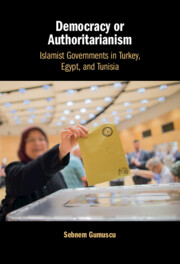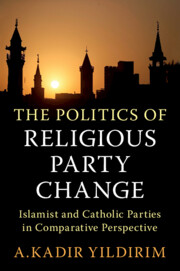77 results
Explaining the distinction between religious and political activism in Islamism: evidence from the Tunisian case
-
- Journal:
- Politics and Religion , First View
- Published online by Cambridge University Press:
- 15 April 2024, pp. 1-19
-
- Article
-
- You have access
- Open access
- HTML
- Export citation
18 - Islam and Nationalism
- from Part II - Transnational and Religious Missions and Identities
-
-
- Book:
- The Cambridge History of Nationhood and Nationalism
- Published online:
- 08 November 2023
- Print publication:
- 09 November 2023, pp 395-416
-
- Chapter
- Export citation
Introduction - Heroes or Hostages
-
- Book:
- Heroes to Hostages
- Published online:
- 03 August 2023
- Print publication:
- 24 August 2023, pp 1-14
-
- Chapter
- Export citation
14 - Islamism’s Missed Opportunities to Promote Liberalism
- from Part IV - Economic Hindrances
-
- Book:
- Freedoms Delayed
- Published online:
- 20 July 2023
- Print publication:
- 20 July 2023, pp 254-266
-
- Chapter
- Export citation
7 - Religious Freedoms in Middle Eastern History
- from Part III - Religious Repression
-
- Book:
- Freedoms Delayed
- Published online:
- 20 July 2023
- Print publication:
- 20 July 2023, pp 111-132
-
- Chapter
- Export citation
16 - The Elusive Dream of Pan-Islamism
- from Part III - Religious Nationalism
-
-
- Book:
- The Cambridge Companion to Religion and War
- Published online:
- 04 May 2023
- Print publication:
- 11 May 2023, pp 332-348
-
- Chapter
- Export citation
‘Human Rights…But for the Majority’: The Appropriation and Subversion of the Human Rights Agenda by Right-Wing NGOs in Malaysia
-
- Journal:
- TRaNS: Trans-Regional and -National Studies of Southeast Asia / Volume 12 / Issue 1 / May 2024
- Published online by Cambridge University Press:
- 24 April 2023, pp. 1-26
-
- Article
-
- You have access
- Open access
- HTML
- Export citation
6 - Performing the Nation, Imagining Citizenship: School Rituals and Oppositional Non-belonging
-
- Book:
- Schooling the Nation
- Published online:
- 16 March 2023
- Print publication:
- 23 March 2023, pp 156-184
-
- Chapter
-
- You have access
- Open access
- HTML
- Export citation
1 - The Late Mubarak Era, Education and the Research
-
- Book:
- Schooling the Nation
- Published online:
- 16 March 2023
- Print publication:
- 23 March 2023, pp 23-54
-
- Chapter
-
- You have access
- Open access
- HTML
- Export citation
Conclusion
-
- Book:
- Democracy or Authoritarianism
- Published online:
- 09 March 2023
- Print publication:
- 16 March 2023, pp 255-266
-
- Chapter
- Export citation

Democracy or Authoritarianism
- Islamist Governments in Turkey, Egypt, and Tunisia
-
- Published online:
- 09 March 2023
- Print publication:
- 16 March 2023
Introduction
-
- Book:
- The Politics of Religious Party Change
- Published online:
- 22 December 2022
- Print publication:
- 05 January 2023, pp 1-20
-
- Chapter
- Export citation
1 - Explaining Religious Party Change
-
- Book:
- The Politics of Religious Party Change
- Published online:
- 22 December 2022
- Print publication:
- 05 January 2023, pp 21-50
-
- Chapter
- Export citation
List of Interviews
-
- Book:
- The Politics of Religious Party Change
- Published online:
- 22 December 2022
- Print publication:
- 05 January 2023, pp 297-300
-
- Chapter
- Export citation

The Politics of Religious Party Change
- Islamist and Catholic Parties in Comparative Perspective
-
- Published online:
- 22 December 2022
- Print publication:
- 05 January 2023
Introduction
-
- Book:
- Sunni City
- Published online:
- 10 November 2022
- Print publication:
- 24 November 2022, pp 1-27
-
- Chapter
- Export citation
1 - Tripoli’s City Corporatism and Identity Politics during the Nationalist Era (1920–1979)
-
- Book:
- Sunni City
- Published online:
- 10 November 2022
- Print publication:
- 24 November 2022, pp 28-60
-
- Chapter
- Export citation
6 - Tripoli’s Islamists
-
- Book:
- Sunni City
- Published online:
- 10 November 2022
- Print publication:
- 24 November 2022, pp 175-193
-
- Chapter
- Export citation
2 - Regional Proxy War
-
- Book:
- Sunni City
- Published online:
- 10 November 2022
- Print publication:
- 24 November 2022, pp 61-85
-
- Chapter
- Export citation
The Repertoires of Religious Nationalism: The Case of İsmet Özel
-
- Journal:
- Nationalities Papers / Volume 52 / Issue 2 / March 2024
- Published online by Cambridge University Press:
- 20 October 2022, pp. 380-396
- Print publication:
- March 2024
-
- Article
-
- You have access
- Open access
- HTML
- Export citation



